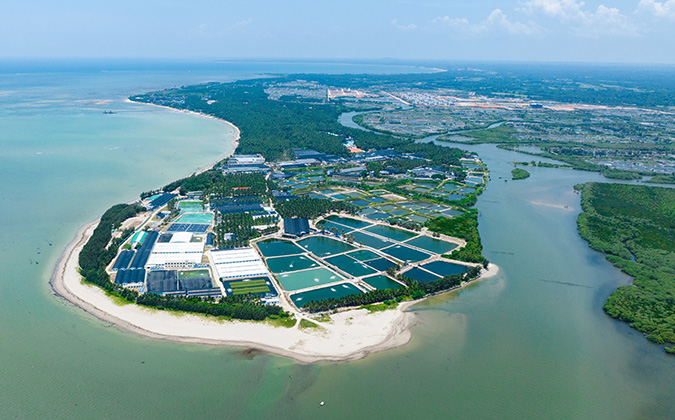
Fish Farm Forum is pleased to host this editorial page on behalf of Pharmaq.
Pharmaq
Novel parasiticide part of quest for long-lasting sea lice control in Chile
This article includes information about authorized veterinary medicines and is intended for professional fish health personnel only.
An interview with Gerardo Lillo, DVM, technical assistant and parasiticides specialist for PHARMAQ Chile.
Q: It has been 2 years since PHARMAQ Alpha Flux® was registered for use against Caligus sea lice in Chilean salmon farming. To what extent is it used in the industry?
GL: First of all, it’s worth mentioning that not all farming sites in the Chilean salmon industry require the use of a product like Alpha Flux. For example, sites located in estuarine zones (brackish water) and areas of the extreme south of Chile (XII Region) tend not to be seriously affected by Caligus.
In this context, during the last 2 years until December 2021, we estimate that we have been able to cover approximately 70% of the Atlantic salmon farming sites with a high risk of infestation and that are targets for Caligus-control therapy.
Currently, almost all Atlantic salmon producers affected by caligidosis have incorporated Alpha Flux as a useful and effective tool in their parasite-control strategy.
Q: How long a period of protection can producers expect from the product?
GL: The duration of the protection period will depend on the initial concentration of hexaflumuron, the active pharmaceutical ingredient, and the challenge to which the sea sites are exposed. According to the data we have, considering all the cages treated with Alpha Flux, the median of the first antiparasitic treatment after Alpha Flux is estimated at 26.9 weeks.
Within these same data, it appears that 19% of the cages treated do not carry out any additional antiparasitic treatment until harvest.1
Overall, the results have shown that the product provides an important protection period during the growth of fish in seawater, which translates into an increase in fish-welfare standards and increased productivity.
Q: Can you describe some of the best practices for use?
GL: Alpha Flux is marketed and authorized to be used in therapies at sea sites. The requirements for therapy are that the fish must be in optimal condition, without gill problems, contained in clean nets. If there is presence of adult stages of Caligus, other products must be used prior to treatment.
Then, there must be a strict calculation of the volume of water for the treatment to achieve the optimum parts per million of hexaflumuron.
Alpha Flux is not designed to treat high parasite burdens of adult stages at a given time; rather it was developed to prevent such an event from occurring by stopping the juvenile stages from developing into adults. If sea lice populations increase to an average of three adult females per fish at a later time, additional treatment with an alternative sea-lice-control product is necessary, as regulations penalize those levels of parasitic load in fish.
Alpha Flux is still relatively new to Chilean aquaculture, so special care is required to ensure it is being used correctly. For optimal results of the therapy, it is critical to follow the product application instructions. For this, we provide constant training and technical-support visits to clients to ensure proper administration.
After the bath treatment, it is also necessary to evaluate the initial concentration of the active ingredient in the fish. The concentration obtained through this testing relates to the therapeutic effect and shows whether the therapy was carried out according to the application recommendations.
Q: There are other products available for producers to use against Caligus. How does this differ?
GL: It is different from other products used against sea lice, so the technical support our veterinarians give to customers is so important for getting good results.
The products that have been used most in recent years for the treatment of Caligus in the sea are bath treatments, which kill the parasites on contact with no residual effect. Alpha Flux works differently, whereby the active molecule, hexaflumuron, is absorbed by the fish and distributed to the tissues, providing a long-lasting protective effect.
Rather than having a “knock down” effect that kills the sea lice on contact, Alpha Flux stops the juvenile stages of Caligus from being able to molt properly, so they don’t develop into adult lice and therefore can’t complete their lifecycle.
On average, cages treated with Alpha Flux require a further 2.6 bath treatments in the production cycle. This is a vast improvement on previous methods. Before Alpha Flux, some sea sites treated for Caligus 10 to 15 times over a production cycle.
Q: Does the product avoid the kind of resistance issues that have affected efficacy of parasiticides in the past?
GL: Resistance to parasiticides is a major issue in Chilean aquaculture, with the effectiveness of some of the widely used actives such as deltamethrin dropping to lower than 40% in some cases.
There has been no documented resistance to hexaflumuron to date, and although the reasons for this have yet to be fully explored, the fact that it acts on juveniles, which subsequently die, may prevent resistance being passed on to the next generation.
Though the risk of resistance at present appears to be very low, it is a situation being constantly monitored, and we are in contact with specialists in this area to see if resistance to the product is being generated.
1 Aquabench commercial data. 2021
Posted on: July 12, 2022







